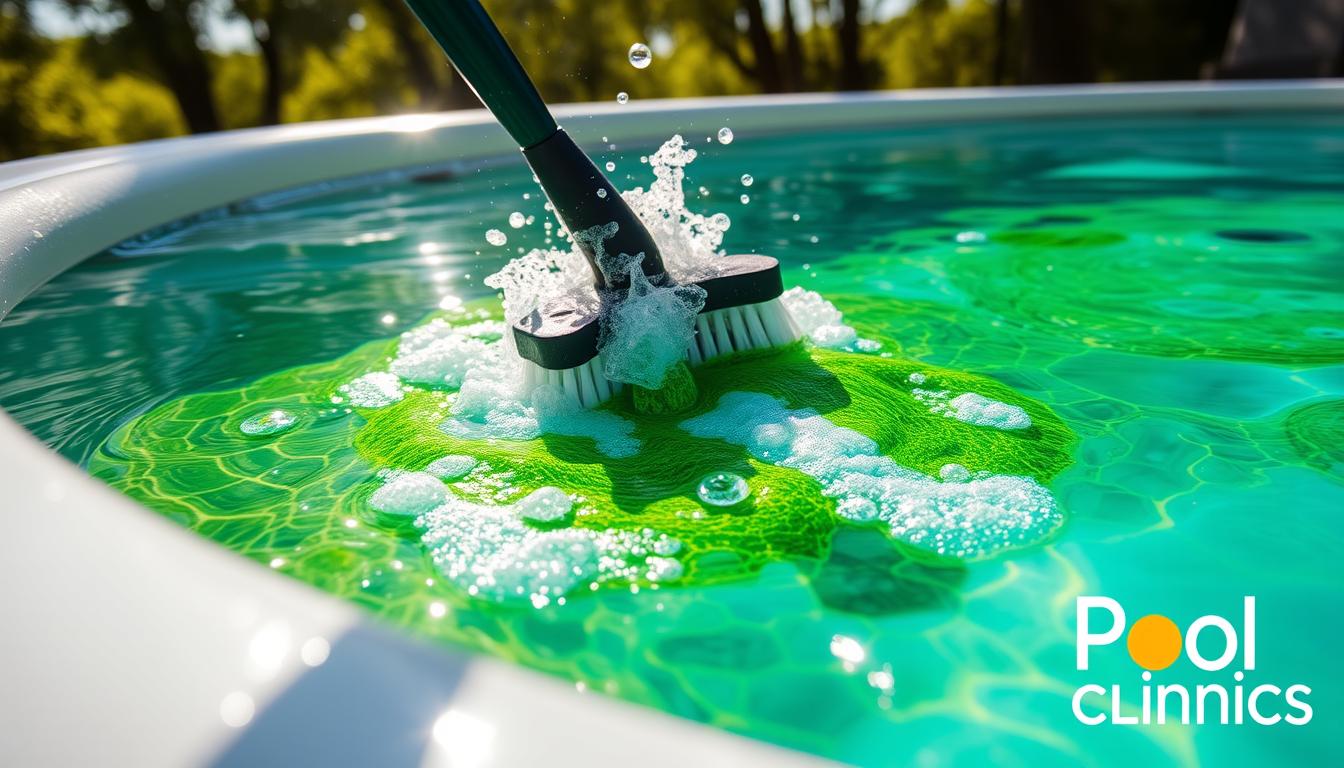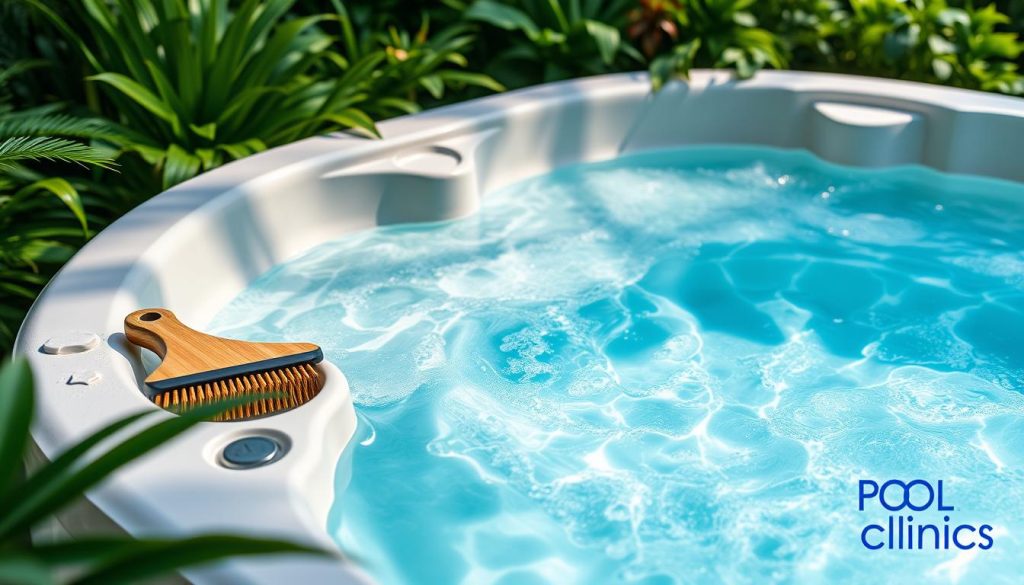
Hot tub owners dream of soaking in crystal-clear water that rejuvenates mind and body. Unfortunately, biofilm can turn our oasis into a breeding ground for harmful contaminants. This slimy layer of bacteria, oils, and residues accumulates over time.
In 2023, adults use an average of 12 personal care products daily. This exposes hot tub water to 112 unique ingredients. Sweat, hair, and dead skin cells also contribute to biofilm formation.
Biofilm consumes sanitizers, affects pH balance, and harbors harmful bacteria. It can cause cloudy water, foamy surfaces, foul odors, and skin irritations.
Don’t worry, hot tub fans! We can fight biofilm and restore our tubs to their former glory. Let’s explore biofilm removal techniques and effective elimination methods.
You’ll learn to keep your hot tub clean, safe, and inviting for years. Together, we’ll say goodbye to biofilm and hello to crystal-clear waters!
Key Takeaways
- Biofilm is a slimy layer of bacteria, body oils, lotions, and other residues that can accumulate in hot tubs over time.
- Signs of biofilm buildup include cloudy or foamy water, foul odors, skin irritations, and increased chemical consumption.
- Effective hot tub sanitization methods include regular shocking, purging, and filter cleaning or replacement.
- Draining and thoroughly cleaning the hot tub is necessary for complete biofilm removal.
- Maintaining proper water chemistry and encouraging good hygiene practices can prevent future biofilm growth.
Understanding Hot Tub Biofilm
Biofilm is a common problem in hot tubs and pools. It creates a protective layer that resists sanitizers like chlorine or bromine. Even new tubs can have biofilm issues, which use up sanitizers and regrow once spent.
Biofilm makes it hard to maintain sanitizer levels. It can lead to increased chemical use and water quality problems if not removed.

What is Biofilm in a Hot Tub?
Hot tub biofilm is a slimy layer of bacteria, fungi, and other substances. It includes microorganisms, body oils, and residues that build up over time. An average person adds 100 million bacteria to hot tub water.
Adults use about 12 personal care products daily, adding to water substances. At 102◦ F, hot tub users can sweat up to three pints per hour.
Many hot tubs have over 100 feet of pipe that can harbor biofilm. This biofilm consumes chlorine and houses harmful bacteria colonies.
Signs of Biofilm Accumulation
Excessive biofilm buildup causes foamy or cloudy water and pH imbalance. It also leads to increased chemical usage and off-color water. Other signs include:
- More chemicals used than normal for sanitation
- Foam on the water surface
- Unpleasant smell
- Oily bubbles around filters
- Calcium flakes
- Slimy water
- Skin irritation
Causes of Biofilm Growth
Biofilm enters a hot tub through bathers’ bodies. It builds up in pipes and plumbing. Bacteria protect themselves with a slime layer against sanitizers and chemicals.
Poor maintenance and high traffic increase biofilm accumulation. Low alkalinity (below 80 ppm) can cause acidic water, leading to skin irritations and spa damage.
All hot tubs can get biofilm, with new or heavily-used tubs at higher risk. Prevent biofilm by covering the tub when not in use and cleaning the filter regularly.
Test pH and alkalinity weekly. Maintain proper water chemistry and circulation. Drain and clean the hot tub thoroughly every few months to prevent biofilm growth.
How to Get Rid of Biofilm in Hot Tub
Biofilm in hot tubs can create unsafe conditions. A thorough cleaning process is key to eliminate biofilm. This includes purging equipment, shocking water, and cleaning filters.
These steps ensure a clean and safe soaking experience. Regular hot tub maintenance keeps your tub in top shape.
Purging the Hot Tub Equipment
Start by purging the hot tub equipment. Clean inner lines, pumps, jets, and hidden areas where biofilm grows. Use a special purging solution to loosen biofilm and debris.
Eco3spa Step 1 Cleaner works well when used every 3 months. It helps keep hot tubs clean and safe.
Shocking the Hot Tub Water
After purging, shock the hot tub water. Raise the free chlorine level to kill bacteria and fungi. The required chlorine levels depend on your spa type.
For spas with an ORP controller, keep free chlorine at 3.0 ppm. Without an ORP controller but with stabilizer, aim for 6.0 ppm.
| Spa Type | Free Chlorine Level (with ORP Controller) | Free Chlorine Level (with Stabilizer, no ORP Controller) |
|---|---|---|
| Hot Tub | 3.0 ppm | 6.0 ppm |
| Swimming Pool | 1.0 ppm | 2.0 ppm |
To shock effectively, super-chlorinate to 20 ppm of free chlorine. Maintain this level for 10 hours while running the filtration system. This eliminates remaining biofilm and disinfects the water thoroughly.
Cleaning and Replacing Filters
Proper filter care prevents biofilm growth. Clean filters regularly as per manufacturer instructions. Replace worn or damaged filters to maintain water quality.
Poor filter function can lead to ongoing biofilm issues. This can compromise your hot tub’s water quality.
Immaculately clean plumbing in a hot tub leads to cleaner, clearer, and fresher water, reducing the need for excess sanitizers.
Follow these hot tub maintenance tips to eliminate biofilm effectively. Use proper hot tub water treatment methods for a safe, enjoyable soak.
Perform these steps regularly to prevent biofilm buildup. This will help maintain optimal water quality in your hot tub.
Effective Biofilm Removal Through Draining
Draining the hot tub is the most powerful method for thorough cleaning. It’s crucial for eliminating stubborn biofilm accumulation. This process ensures a safe, hygienic soaking environment.
Step-by-Step Guide to Draining and Cleaning
To clean a hot tub by draining, follow these steps:
- Drain the water using a hose or submersible pump.
- Brush and scrub all surfaces, including jets and filters, to loosen any biofilm or debris.
- Thoroughly clean the inside of the hot tub using a specialized hot tub cleaner or a mixture of water and white vinegar.
- Refill the hot tub with fresh water.
- Check and balance the chemical levels to ensure proper water chemistry.
- Add a strong dose of sanitizers and algaecides to prevent future biofilm growth.
According to recent studies, hot tubs should be drained and deep cleaned every three to four months to effectively remove biofilm buildup. Signs that indicate the need for a deep clean include slime forming in the water, cloudy water, musty odors, decreasing chemical levels, skin rash after use, and prolonged periods of non-use.
Balancing Water Chemistry After Refilling
After refilling, test the water to ensure proper pH, alkalinity, and sanitizer levels. This step is crucial for preventing biofilm regrowth. It also maintains overall water quality.
| Parameter | Ideal Range |
|---|---|
| pH | 7.4 – 7.6 |
| Alkalinity | 100 – 150 PPM |
| Chlorine | 1.0 – 3.0 PPM |
| Bromine | 2.0 – 4.0 PPM |
Maintain these ideal ranges to prevent biofilm buildup. Perform weekly water chemistry tests and regular maintenance. These practices ensure a clean, healthy hot tub experience.
Conclusion
Keeping your hot tub clean is vital for its longevity and user health. Biofilm prevention is key to hot tub maintenance. Follow simple care tips to avoid this unwanted buildup. Maintain ideal temperature, pH, chemical, and alkalinity levels. Clean filters daily and sanitize with chlorine or bromine.
Shock the hot tub weekly or after heavy use. Drain every 2 to 3 months and close the lid when not in use. Using a hot tub with biofilm can cause health issues. These include skin rashes, breathing problems, and ear or eye infections.
Avoid using a hot tub with low sanitation levels. Regular maintenance prevents biofilm and ensures a safe, enjoyable space. If unsure about biofilm removal, contact a professional pool service company. They have the expertise to keep your hot tub clean and healthy.
Proper maintenance and following these tips will let you enjoy your hot tub worry-free. You can relax without concerns about harmful bacteria or unsanitary conditions. Invest in good care for years of safe, enjoyable hot tub use.







